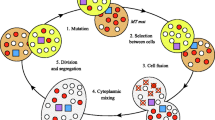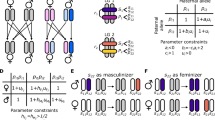Abstract
In most sexually reproducing species, including humans, mitochondria and other cytoplasmic elements are uniparentally (usually maternally) inherited. This phenomenon is of broad interest as a mechanism for countering the proliferation of selfish mitochondria. Uniparental inheritance can be enforced either by the female gametes excluding male cytoplasm or male gametes excluding their own from the zygote. Previous studies have shown that male-enforced uniparental inheritance is unlikely to evolve as a primary mechanism, because unlike female enforcement, the positive linkage disequilibrium between the modifier for eliminating the gamete’s own mitochondria and a wild-type mitochondrial complement is broken from one generation to the next. However, it has been proposed that with a sufficiently high mutation rate and strong selection, elimination of the gamete’s own mitochondria could be favored by selection. In this article, a series of numerical simulations confirm that this is indeed the case, although the conditions where male enforcement is favored are quite restrictive. Specifically, in addition to a high mutation rate to selfish mitochondria and strong selection against them, the cost of uniparental inheritance must be negligible.








Similar content being viewed by others
References
Birky CW (1995) Uniparental inheritance of mitochondrial and chloroplast genes: mechanisms and evolution. Proc Natl Acad Sci USA 92:11331–11338
Burt A, Trivers R (2006) Genes in conflict. Harvard University Press, Cambridge
Cosmides L, Tooby J (1981) Cytoplasmic inheritance and intragenomic conflict. J Theor Biol 89:83–129
Faure S, Noyer J-L, Carreel F, Horry J-P, Bakry F, Lanaud C (1994) Maternal inheritance of chloroplast genome and paternal inheritance of mitochondrial genomes in bananas. Curr Genet 25:265–269
Fisher RA (1930) The genetical theory of natural selection. The Clarendon Press, Oxford
Hastings IM (1992) Population genetic aspects of deleterious cytoplasmic genomes and their effect on the evolution of sexual reproduction. Genet Res 59:215–225
Hoekstra RF (1990) Evolution of uniparental inheritance of cytoplasmic DNA. In: Maynard Smith J, Vida J (eds) Organizational constraints on the dynamics of evolution. Manchester University Press, Manchester
Hurst LD (1995) Selfish genetic elements and their role in evolution: the evolution of sex and some of what that entails. Philos Trans R Soc Lond B 249:321–332
Kimura M, Maruyama T (1966) The mutational load with epistatic selection on fitness. Genetics 54:1337–1351
Kondrashov AS (1988) Deleterious mutations and the origin of sexual reproduction. Nature 336:435–440
Mason RJ, Horsinger KE, Jason RK (1994) Biparental inheritance of the chloroplast genome in Coreopsis. J Hered 85:171–173
Matlab (2007) The Mathworks Co, Natick
Maynard Smith J (1978) The evolution of sex. Cambridge University Press, Cambridge
Maynard Smith J (1982) Evolution and the theory of games. Cambridge University Press, Cambridge
Neale DB, Marshall KA, Sederoff RR (1989) Chloroplast and mitochondrial DNA are paternally inherited in Sequioa sempervirens. Proc Natl Acad Sci USA 86:9347–9349
Price GR (1970) Selection and covariance. Nature 227:520–521
Randerson JP, Hurst LD (1999) Small sperm, uniparental inheritance, and selfish cytoplasmic elements: a comparison of two models. J Evol Biol 112:110–1124
Sears BB (1980) Elimination of plastids during spermatogenesis and fertilization in the plant kingdom. Plasmid 4:233–255
Strand MK, Copeland WC (2002) Measuring mtDNA mutation rates in S. cerevisiae using mtArg assay. Methods Mol Biol 197:1064–3745
Whatley JM, John JM, Whatley FR (1979) From extracellular to intracellular: the establishment of mitochondria and chloroplasts. Proc R Soc Lond B 204:165–187
Zouros E, Ball AO, Saavedra C, Freeman KR (1994) An unusual type of mitochondrial DNA inheritance in the blue mussel Mytilus. Proc Natl Acad Sci USA 91:7463–7467
Acknowledgments
The authors thank Austin Burt for helpful discussion, particularly concerning the role of epistasis. M. Shpak was supported by URI Grant 14-6485-9651.
Author information
Authors and Affiliations
Corresponding author
Rights and permissions
About this article
Cite this article
Sreedharan, V., Shpak, M. Selection for male-enforced uniparental cytoplasmic inheritance. Theory Biosci. 129, 295–306 (2010). https://doi.org/10.1007/s12064-010-0113-9
Received:
Accepted:
Published:
Issue Date:
DOI: https://doi.org/10.1007/s12064-010-0113-9




